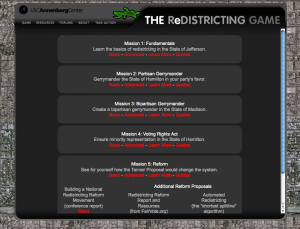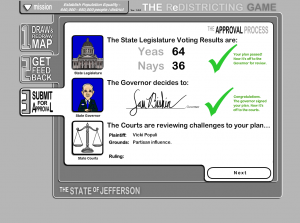I confess, the reason why I wanted to do this post was because I thought the idea of a game about congressional redistricting is pretty funny and because it felt like such an odd subject to make a game out of. But, on further thought, I realized that for the layperson, it is an opportunity to get reacquainted with how districts are drawn in the good ol’ US of A. Ok, for me. It was a good chance for me to get reacquainted with it because I totally hated government in high school and tried to spend most of the class asleep. In fact, I really don’t even remember taking it. So, I thought I’d share my findings with you in case you find it useful, what with the census results coming out, 2012 coming up and the Republicans finally starting to get their act together and finding some people who are willing to run.

Anyways, why don’t we start with looking at what redistricting is again. It is the practice where a state government can divide up areas into legislative districts to reflect the density of population and determine how many of the 435 representatives it sends to Congress. Districts are usually redrawn every 10 years after the census is taken, which is why people get really uptight over whether or not you fill a damn form out with something other than the name “Mickey Mouse”.
However, redistricting can also be known by its evil twin name, gerrymandering. That is when districts are divided up in favor of a particular incumbent or political party and can be drawn along voting lines or racial groupings. For example, one way to do this is if you have an area that has a lot of Republicans surrounded by a lot of Democratic voters, the area could be redrawn so that it splits the Republican voters and restricts them to a minority in the two districts. This is legal until someone gets pissed off and brings a lawsuit against it as in the case of Tom Delay and his money-funneling-mid-census-term redistricting spree. Interesting side note: The term was coined when in 1812 the governor of Massachusetts, Eldbridge Gerry, had signed a bill that redistricted it to benefit his party (confusingly named the Democratic-Republic party). One of the districts was said to look like a salamander because of how it was drawn. Someone made a hybrid of the two names resulting in the term gerrymander. For more on redistricting, it is worth taking a listen to this episode of the Diane Rehm show that first sparked my interest.
But, it is pretty common to gerrymander and seems to help shape the country into being even more partisan. So, a game was born. Is it possible to redistrict the US along non-partisan lines? Some people think so. Professor Nathaniel Persily, a guest on the show, has got his students at Columbia Law School trying their hand at it. So, I thought I would too. After clicking past the opening screen, I was presented with quite a few options. I chose the basic fundamental level which is where I’m at anyways.
After the game loaded, I had to choose my party. Now, for someone who is a little anti-party, I bristled a bit but whatever. It’s all in the name of science. The head of my party is Libby Raul. Well, hello there, Libby! Nice Hillary hair and Nancy Pelosi suit.
Next I got my mission. I needed to look at my district representatives to find out their concerns. The first time I went through this, I blindly didn’t care and just went to the redrawing, which is what I’m good at – drawing. I thought I’d try an early period Baroque-esque theme. Apparently all of the reps in my districts are Democrats which is probably because of the basic level.
When redrawing the districts, I had to balance out the populations to be 650K-ish each. But this is the first time around when I did not know I had to look at my representatives’ concerns nor did I realize that all those dots were Republicans or Democrats. I was concentrating more on balancing out the populations, kinda like on Sim City.
Then I had to submit my masterpiece for approval.
Luckily everyone enjoyed my conceptual sense of space and balance and approved my plan. Ultimately there were no court challenges to my artistic awesomeness.
So that’s the game! Besides the artistic factor, I found it a fun and an engaging way to visualize and learn about a subject which has always escaped me up until now.
What could be result of all of this? It could spur more public interest in redistricting law reform to restrict the practice of gerrymandering. And if we are able to redraw lines to reflect a population change rather than favor a particular side, according to Matthew Frankel at the Brookings Institution, it might go a way in encouraging Congress to work across the aisle. At the very least it can help create a better-informed public about our political process and that is always extremely valuable.






